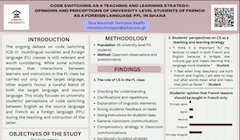Code Switching as a Teaching and Learning Strategy: Opinions and Perceptions of University-Level Students of French as a Foreign Language (FFL) in Ghana
DOI:
https://doi.org/10.20343/teachlearninqu.11.29Keywords:
code switching, foreign language teaching, French as a foreign language, learning strategiesAbstract
The ongoing debate on code switching (CS) in multilingual societies and Foreign Language (FL) classes is still relevant and worth considering. This linguistic phenomenon simply refers to altering from one language to another during speech and writing (Richards and Schmidt 2013). While some authorities propose that interactions between learners and instructors in the FL class be carried out only in the target language, other opinions favour a careful blend of both target and source languages. Ghana, a multilingual country in West Africa, adopted English as its official language during the colonial era. French was later introduced to promote regional integration among Ghana and her neighbours, especially since Ghana is greatly surrounded by francophone countries within the subregion (Gandolfi et al. 2021). French has since then been the second most widely taught FL in the country, with a presence in almost all stages of the Ghanaian academic trajectory. This multilingual position of Ghana makes it common to find elements of CS present in FL classrooms, where both instructors and learners occasionally resort to English for instructional conversations (Chachu 2016). This study focuses on university students’ perceptions of CS between English as the source language and French as a foreign language (FFL) during the instruction of the latter. Some frameworks for teaching and learning FFL in Ghana prefer that the language of instruction and interaction be limited to the target language only (Soku and Azanku 2015). The Common European Framework of References for Languages (CEFR) however, suggests the possible use of CS for purposes of instruction when there are favourable conditions (Council of Europe 2001). To identify the roles of CS and investigate FL students’ opinions on this, our data was gathered from classroom observations and questionnaires that had both Likert scale and open-ended questions. This was at the end of their first semester of studying university-level FFL. It was observed that CS plays a significant role in the understanding of linguistic concepts and greatly improves students’ engagement and participation in the FL class. Of the 36 respondents, 34 felt their academic needs were met when the language of instruction and interaction alternated between French and English. Twenty-nine students reported losing focus easily in the FFL class in instances where the medium of interaction was limited to French alone, while 26 reported feeling nervous whenever they were asked to only communicate in French. For metalinguistic aspects of the language, 33 students, constituting 91.7% were of the view that a careful blend of English and French could go a long way to aid their understanding and foster the learning of grammatical concepts. Generally, students attested to better retention of vocabulary in the target language when there was a good blend of both languages. It is recommended therefore that language instructors resort periodically to CS to ensure understanding and engagement from students. CS also helps learners have the opportunity to intervene with their limited linguistic structures when they are faced with linguistic challenges in the FL classroom.
Click here to read the corresponding ISSOTL blog post.
Downloads
References
Chachu, Sewoenam. 2016. “‘I am Speaking French but I am Thinking in English’: An Analysis of Errors by Students of the French Language at the University of Ghana.” Ghana Journal of Linguistics 5 (1), 37–54. https://doi.org/10.4314/gjl.v5i1.73. DOI: https://doi.org/10.4314/gjl.v5i1.73
Council of Europe. Council for Cultural Co-operation. Education Committee. Modern Languages Division. 2001. Common European Framework of Reference for Languages: Learning, Teaching, Assessment. UK: Cambridge University Press.
Gandolfi, Franco, Mensimah Thompson Kwaffo, Robert McAndrews, Steven J. Sacco., and Kathleen Stein-Smith. 2021. “French Language and Francophone Culture in Sub-Saharan Africa—Interdisciplinary Reflections on Multilingualism and French Language Education.” International Journal of Humanities and Social Science 11 (10): 29–39. https://doi.org/ 10.30845/ijhss.v11n10p5.
Richards, Jack C., and Richard W. Schmidt.2013. Longman Dictionary of Language Teaching and Applied Linguistics. New York: Routledge. DOI: https://doi.org/10.4324/9781315833835
Soku, Dennis, and Winnand Kofi Azanku. 2015. “Pertinence de l’Alternance Codique en Classe de Français Langue Étrangère (FLE). Etude de Cas Chez les Apprenants et Enseignants dans Deux Lycées au Ghana.” Research on Humanities and Social Sciences 22: 64–73. https://api.semanticscholar.org/CorpusID:146488763.

Downloads
Published
How to Cite
Issue
Section
License
Copyright (c) 2023 Ekua Mensimah Thompson Kwaffo

This work is licensed under a Creative Commons Attribution-NonCommercial 4.0 International License.


